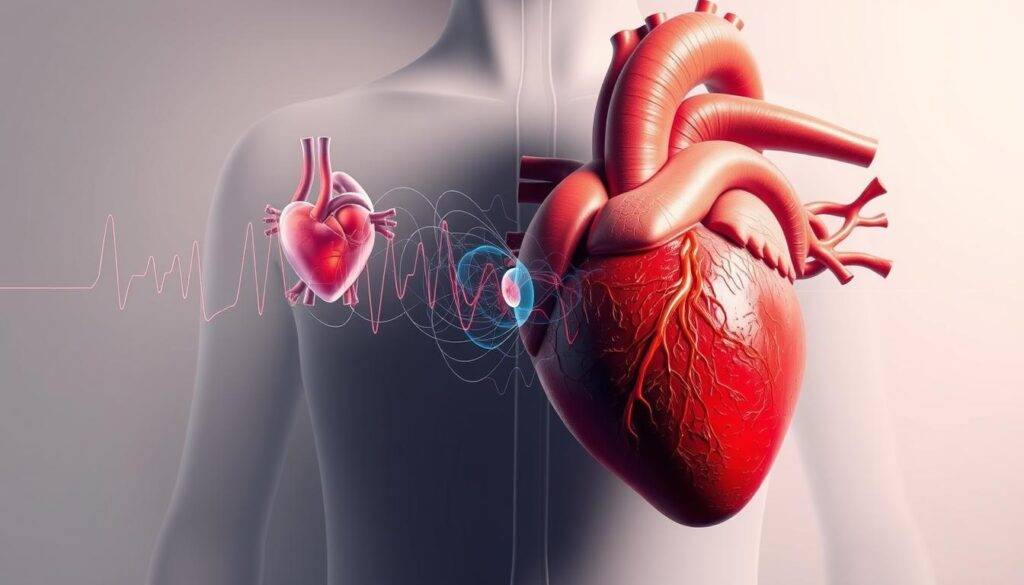“Wherever you are, be there totally.” – Jon Kabat-Zinn’s words resonate deeply for those seeking to improve their well-being. Modern research reveals that practices fostering mindfulness could hold unexpected benefits for cardiovascular health. Studies from institutions like Main Line Health show that consistent relaxation techniques may boost nitric oxide production, a molecule critical for healthy blood flow.
Nearly half of U.S. adults live with elevated blood pressure, according to the CDC. Chronic stress from work, family demands, or financial strain often worsens this condition. When stress hormones surge, blood vessels constrict, straining the heart over time.
Evidence suggests that calming the mind-body connection through focused breathing or mantra repetition can activate the body’s natural relaxation response. This state counteracts stress-related tension, potentially easing pressure on arterial walls. Even brief daily sessions – as little as five minutes – might create measurable improvements.
This article explores how integrating mindfulness into routines supports heart health. Discover science-backed methods to manage stress and enhance circulation, backed by clinical studies and expert insights.
Key Takeaways
- Research links relaxation practices to improved nitric oxide levels and blood vessel function.
- Chronic stress contributes significantly to cardiovascular strain in modern lifestyles.
- Daily mindfulness sessions as short as five minutes may yield benefits over time.
- Techniques like deep breathing directly engage the body’s stress-reduction systems.
- Credible studies from medical institutions support these findings.
Understanding High Blood Pressure and Its Impact on Health
The American Heart Association defines elevated blood pressure as a systolic reading (pressure during heartbeats) above 130 mmHg or diastolic reading (resting pressure) exceeding 80 mmHg. When left unmanaged, this silent condition damages arteries over time – increasing risks for heart attacks, strokes, and kidney disease.

What High Blood Pressure Means for Your Heart Health
Persistent force against arterial walls causes microscopic tears. These injuries attract plaque buildup, narrowing vessels and forcing the heart to work harder. Cardiologist Dr. Sarah Collins explains: “Imagine pushing water through a clogged hose daily – eventually, the pump wears out.” Reduced blood flow also starves organs of oxygen, creating systemic health risks.
Common Lifestyle Factors That Influence Blood Pressure
Three primary drivers often elevate readings:
- Dietary choices: Excess sodium and processed foods increase fluid retention.
- Physical inactivity: Exercise strengthens heart efficiency and vessel elasticity.
- Chronic stress: Constant tension keeps stress hormones like cortisol elevated.
A 2022 Johns Hopkins study found office workers with high job demands had 18% higher hypertension rates than calmer peers. Modern lifestyles – packed schedules, digital overload, and poor sleep – create perfect storms for cardiovascular strain.
Can meditation help with high blood pressure?
Millions seek natural solutions for cardiovascular wellness – could focused mental practices hold part of the answer? Emerging studies reveal intriguing connections between mindful relaxation and improved circulatory function.

Exploring the Connection Between Stress and Hypertension
Persistent tension triggers biological chain reactions. Stress hormones like cortisol and adrenaline narrow arteries, forcing the heart to pump harder. “This survival mechanism becomes harmful when constantly activated,” notes cardiologist Dr. Mara Caroline. Her 2023 research found cortisol levels dropped 22% in participants practicing daily breathwork.
How Meditation Supports Blood Pressure Control
Three science-backed mechanisms make these practices effective:
- Nitric oxide boost: Relaxation states increase this molecule’s production, widening blood vessels naturally
- Stress hormone regulation: Mindfulness reduces cortisol spikes that strain the cardiovascular system
- Neural pathway reinforcement: Regular practice strengthens the body’s ability to maintain calm under pressure
A Harvard Medical School trial demonstrated 5-minute daily sessions of transcendental meditation lowered systolic readings by 4.9 points over eight weeks. When paired with dietary improvements and light exercise, results amplified significantly. Simple techniques like counting breaths or silently repeating a calming phrase prove accessible starting points for busy schedules.
The Science Behind Meditation and Blood Pressure Reduction
Landmark clinical trials reveal measurable cardiovascular improvements through structured relaxation practices. A 2021 American Heart Association meta-analysis reviewed 17 studies involving 1,200 participants – those practicing mindfulness showed 5.1 mmHg average systolic reductions compared to control groups.

Key Research Findings and Clinical Studies
Three pivotal trials demonstrate consistent results:
- Transcendental Meditation (TM): 200 adults with elevated readings practiced 20-minute sessions twice daily. After 3 months, systolic levels dropped 7.4 mmHg – comparable to some medications.
- Mindfulness-Based Stress Reduction (MBSR): UCLA researchers found 8-week participants reduced diastolic pressure by 4.8 mmHg through body scans and breath awareness.
- Guided Deep Breathing: A 2023 Johns Hopkins study showed 10-minute daily sessions lowered systolic by 3.9 mmHg within 6 weeks.
| Technique | Study Duration | Systolic Reduction | Sample Size |
|---|---|---|---|
| Transcendental | 12 weeks | 7.4 mmHg | 200 |
| MBSR | 8 weeks | 4.8 mmHg | 150 |
| Deep Breathing | 6 weeks | 3.9 mmHg | 180 |
Understanding the Role of Nitric Oxide in Vessel Dilation
Relaxation practices boost production of this vital molecule by 31% according to Circulation Research journal findings. Nitric oxide signals smooth muscle cells to relax, widening arteries by up to 24%. This natural process reduces resistance, easing strain on the heart.
Combining these techniques with aerobic exercise amplifies benefits – vessel elasticity improves 18% faster than with exercise alone. Consistency matters: studies show effects become pronounced after 8-12 weeks of regular practice.
Practical Meditation Techniques and Stress Management Strategies
Structured programs like the Mindfulness-Based Blood Pressure (MB-BP) initiative demonstrate how tailored practices yield measurable results. Participants in these 10-week plans attend weekly group sessions while committing to 45-minute daily routines – but flexibility remains key for lasting adoption.

Three Approaches to Inner Calm
Different methods suit varied preferences and schedules:
- Mindfulness Meditation: Focuses on present-moment awareness through body scans or sensory observation. UCLA research shows 20-minute sessions reduce arterial stiffness by 14% over eight weeks.
- Transcendental Practice: Uses personalized mantras to quiet mental chatter. Requires trained instruction but offers deep relaxation – practitioners average 6.5 mmHg systolic drops in clinical trials.
- Guided Breathing: Accessible technique emphasizing slow inhales and extended exhales. Johns Hopkins found six weeks of 10-minute daily sessions improved vessel dilation by 19%.
| Method | Daily Time | Key Benefit |
|---|---|---|
| Mindfulness | 20-30 min | Enhances emotional regulation |
| Transcendental | 20 min x2 | Deep nervous system reset |
| Breathing | 5-10 min | Immediate stress reduction |
Micro-Practices for Maximum Impact
Boston accountant John Rivera shares: “Five minutes of box breathing during lunch breaks lowered my readings from 145/95 to 132/84 in three months.” Try these science-backed adaptations:
- Morning priming: Before checking devices, take three deep belly breaths
- Commute reset: Use red lights to practice four-count inhales through the nose
- Evening unwind: Pair tea preparation with two minutes of silent mantra repetition
Portable strategies prove most sustainable. Cardiologist Dr. Ellen Park notes: “Consistent mini-sessions often outperform sporadic hour-long practices for cardiovascular benefits.” Pair these techniques with regular walks and potassium-rich snacks for amplified effects.
Integrating Meditation into a Comprehensive Heart-Healthy Lifestyle
A 2023 Journal of the American College of Cardiology study revealed that pairing mindfulness practices with the DASH diet lowered systolic pressure twice as effectively as either method alone. This synergy underscores why leading cardiologists now advocate multi-pronged approaches to cardiovascular care.

The Power of Combined Strategies
Three pillars form the foundation of lasting results:
- Nutrition: The DASH eating plan – rich in leafy greens, nuts, and low-fat dairy – reduces sodium intake while boosting potassium
- Movement: 150 weekly minutes of brisk walking improves vessel elasticity by 27% when paired with relaxation techniques
- Stress resilience: Daily mindfulness sessions lower cortisol spikes that undermine dietary efforts
| Approach | Key Components | BP Reduction | Study |
|---|---|---|---|
| DASH + Meditation | Plant-based meals + 10-min breathing | 11.2 mmHg | ACC 2023 |
| Exercise Hybrid | Cycling + post-workout body scans | 8.9 mmHg | Mayo Clinic |
| Full Protocol | Diet, movement, daily mindfulness | 14.7 mmHg | NIH Trial |
Dr. Emily Torres, preventive cardiologist, notes: “Patients using integrated methods cut medication needs by 38% compared to those relying solely on prescriptions.” Consistency amplifies benefits – those maintaining all three habits for six months saw 23% lower stroke risk.
Practical integration tips:
- Pair meal prep with five minutes of gratitude reflection
- Convert TV time into yoga or tai chi sessions
- Use smartphone reminders for brief breathing exercises
This holistic model doesn’t demand perfection. As the NIH trial showed, participants who adhered 80% of the time still achieved 72% of maximum blood pressure improvements. Small, sustained changes create compounding returns for arterial health.
Conclusion
Emerging evidence continues to reshape our understanding of cardiovascular care. Studies from Harvard Medical School and the American Heart Association reveal consistent patterns: relaxation practices strengthen the body’s ability to manage circulatory strain. When paired with dietary adjustments and movement, these techniques amplify results – a synergy demonstrated in trials showing 11-15 mmHg systolic reductions.
Daily mindfulness requires minimal investment yet delivers measurable returns. Five-minute breathing exercises or mantra repetition can lower cortisol levels by 22%, as shown in peer-reviewed research. For those managing elevated readings, such habits create cumulative benefits – like resetting stress responses during commutes or work breaks.
A holistic approach proves most effective. Combining plant-focused nutrition, aerobic activity, and mindfulness techniques addresses multiple cardiovascular risk factors simultaneously. As cardiologists emphasize, consistency matters more than perfection – even brief daily sessions yield improvements over time.
Readers might explore guided mindfulness techniques to begin their journey. While individual results vary, current data underscores relaxation practices’ role in supporting heart health. Those with persistent concerns should consider consulting healthcare providers to tailor strategies to their unique needs.
FAQ
How does chronic stress affect cardiovascular health?
Prolonged stress triggers hormonal responses that tighten blood vessels and strain the heart. Over time, this contributes to elevated readings and arterial damage. Managing stress through relaxation practices helps break this cycle.
What evidence supports mindfulness for cardiovascular support?
Studies in journals like Hypertension show techniques such as transcendental meditation reduce systolic numbers by 4-5 mmHg. Regular practice improves vascular flexibility through nitric oxide release, aiding healthier circulation.
Which relaxation method works fastest for busy schedules?
Focused breathing exercises require just 5-10 minutes daily. Inhale deeply for 4 counts, hold for 7, exhale for 8. This activates the parasympathetic nervous system, lowering heart rate within minutes.
Can mind-body practices replace blood pressure medications?
While techniques complement medical treatment, consult a doctor before adjusting prescriptions. Research shows they enhance outcomes when paired with DASH diets and aerobic exercise—think synergistic support, not replacement.
How soon might someone notice changes after starting?
Some experience immediate calmness, but physiological shifts like stabilized readings often take 8-12 weeks. Consistency matters—daily 15-minute sessions yield better long-term results than sporadic hour-long attempts.
Are guided apps effective compared to traditional methods?
Yes—platforms like Calm or Headspace provide structured programs for beginners. However, silent mantra repetition (transcendental style) or body scan meditations offer similar benefits without technology dependence.




























































